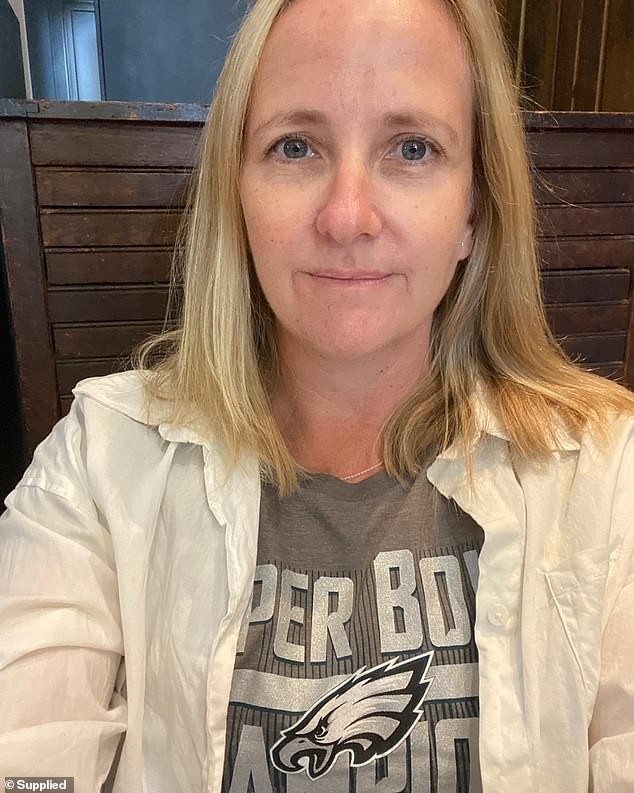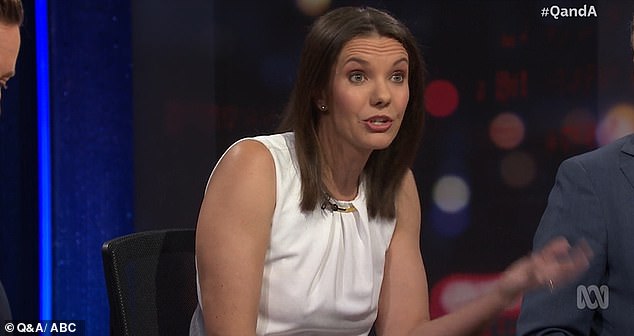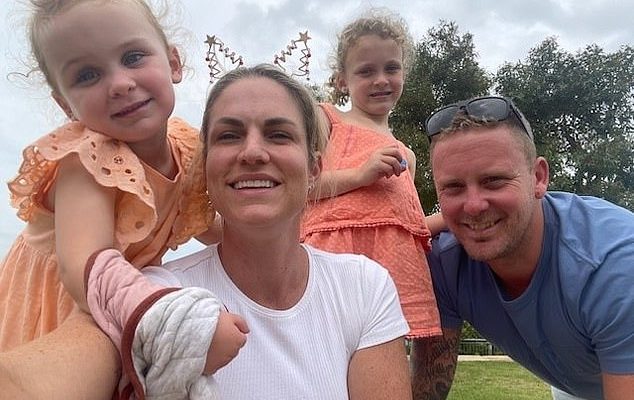Sydney is so expensive thousands of young people are moving out every year so they can buy a house and have children.
Australia’s most populated city housed 156,616 new migrants during the last financial year.
But prohibitively unaffordable housing also meant 38,425 people left in 2022-23, new Australian Bureau of Statistics data showed – a mass exodus.
Jordan Knight, 29, who moved to Sydney from Brisbane four years ago to work in advertising, is now planning to move back to south-east Queensland in the next two years so he and his girlfriend can eventually buy a house and have children.
‘I’m living with my girlfriend who I met in Sydney and we’re talking about moving to the Gold Coast or Brisbane,’ he told Daily Mail Australia.
‘I’m going to be out of here in the next couple of years – it’s just too expensive.
Sydney is so expensive thousands of young people are moving out every year so they can buy a house and have children (pictured is Sandy Wearmouth with her husband Kevin Wearmouth and their daughters Emily, 5, and Lara, 3

Jordan Knight, 29, who moved to Sydney from Brisbane four years ago to work in advertising, is now planning to move back to south-east Queensland in the next two years so he and his girlfriend can eventually buy a house and have children
‘Value for money and the standard of living, for the money that you’re spending, you really do not get that much life.
‘You do get a better standard of life for less money in Brisbane than Sydney.’
Alysia Sheppard, a 44-year-old single mother of two teenage sons, spends $590 a week renting a two-bedroom unit at Dee Why on Sydney’s northern beaches, with part of the living room used as a bedroom.
Despite earning $105,000 a year as a sales rep for a commercial office company, she has to work three other jobs on top of that, including bidding for cleaning and waitressing jobs on Airtasker to pay the bills and Catholic school fees.
A survivor of domestic violence after fleeing an abusive marriage 15 years ago, she is down to her last $5 each month and has to use Afterpay to afford groceries, with a daily cup of takeaway coffee her only luxury following the cancellation of TV streaming services.
‘It’s pay day this week and I’m down to $5,’ she told Daily Mail Australia.
‘I don’t have any emergency savings, I don’t have anything in a home deposit account or anything like that.
‘I don’t live a lavish lifestyle; I don’t buy clothing; I’ve had to rely on Afterpay recently just to buy groceries.
‘Last year, I was working four jobs to try and get by, so my main job, I actually make six figures but it’s just not enough.’
The cost of living crisis is now so bad the Australian Competition and Consumer Commission estimates younger Australians and low-income earners are spending a quarter of their pay on groceries.

Alysia Sheppard, a 44-year-old single mother of two teenage sons, spends $590 a week renting a two-bedroom unit at Dee Why on Sydney’s northern beaches, with part of the living room used as a bedroom

Despite earning $105,000 a year as a sales rep for a commercial office company, Alysia has to work three other jobs on top of that, including bidding for cleaning jobs on Airtasker to pay the bills (Alysia Sheppard is pictured, left, with her sons Oliver, 18, and Harrison, 16
As someone with three degrees, she also can’t qualify for a home loan because of her Higher Education Contribution Scheme debt, which made her a qualified interior designer.
‘I’m also a qualified teacher as well and I have a marketing degree – I’ve got three degrees that I’m trying to pay off,’ she said.
‘I also have a HECS debt as well.’
Ms Sheppard, who moved to Sydney eight years ago from the Gold Coast, is critical of high immigration for causing the housing and cost of living crisis, after a record 548,800 foreigners moved to Australia in the year to September.
Of that number, 186,433 migrants moved to New South Wales, which meant a third of the overseas intake flooded into one state, with most moving to Sydney during a rental crisis.
During the last financial year, 156,616 migrants moved to Sydney.
‘I hear it’s just as difficult everywhere in Australia at the moment with the huge immigration,’ she said.
‘I’m not against immigration, I’m not xenophobic in any way but I just think at the moment it’s too much.’
She would like to leave Sydney but her work requires her to drive to meet wholesale university, school and TAFE customers, who buy commercial office furniture.
‘If I was to move out of Sydney, I’d lose my social network, probably don’t earn as much in other regions.’
Should the banks keep declining her home loan approval, she may have to leave Australia entirely after her youngest son finished high school.
‘I’m actually even considering moving overseas at the moment,’ she said.
‘It all comes down to if I can find a job in that area.’
For almost half Sydney’s median house price of $1.4million, Mr Knight said he could buy something for $750,000 in the suburbs of Brisbane and still be within a reasonable distance of the city.
As a young man, he’s particularly annoyed at politicians suggesting his generation should aspire to live in a small Sydney home unit, with more apartments touted as the solution to a lack of housing supply.
‘For political parties to say that the future is just in a small, windowless dog box in the city – that’s not a future I’m particularly interested in,’ he said.
‘I find it quite offensive that that’s what they want for us.
‘That future that’s being proposed to us is either living inside these smaller apartment units 30 minutes from the city or living in a house an hour from the city.’

Sandy Wearmouth, 37, moved up to Bateau Bay on the NSW Central Coast in September last year, from Rydalmere in Sydney’s west (she is pictured left with her carpenter husband Kevin Wearmouth)
Sandy Wearmouth, 37, moved up to Bateau Bay on the NSW Central Coast in September last year, from Rydalmere in Sydney’s west.
The director of Elara Digital Marketing is now able to work from home, having quit an office-based marketing job in Sydney – and doesn’t miss the stress since moving 88km north.
‘I don’t miss the traffic or the busy lifestyle or the stress,’ she told Daily Mail Australia.
‘I had a four-day a week job, and I was rushing to drop the kids at 7 o’clock at daycare, or before-school care and rushing to work, doing my eight to four, and rushing back home to get them because it had been such a long day.
‘We felt the guilt and I also had to work those hours in order to live – do the mortgage repayments, pay for groceries and the basic cost of living and my eldest daughter was starting school this year and I just felt guilty having to put her into before and after-school care every single day.’
The move an hour north also meant she and her husband Kevin, a carpenter who still works in Sydney, were able to halve their mortgage from $800,000 to $400,000 and live in a house near the beach.
Rydalmere, next to Parramatta, has a median house price of $1.68million, which is significantly dearer than beachside Bateau Bay’s $1.01million, CoreLogic data showed.
‘We’ve significantly reduced our mortgage and it is double the size with a pool and an outlook to the valley and the lake,’ she said.
‘Significantly reducing our mortgage gave me the opportunity to start my own business and work the hours that I need to to also be there for my children without having to be restricted by mortgage repayments and living week to week or month to month.’
The businesswoman, who specialises in social media marketing for business clients, is also able to attend school events with her eldest daughter Emily, 5, and look after three-year old Lara two days a week.
‘My business is gaining a bit of momentum now but I still have the flexibility to go to her events or do extra things with her during the day,’ she said.
‘She does gymnastics and then swimming so we get to do those extra things because I now have the time and the flexibility to spend quality time with the girls.’
The Wearmouths saw the appeal of the Central Coast, having had their wedding at Shelly Beach – the place where they later did summer caravan holidays with their girls.
‘We came up regularly so we were familiar with the area,’ Ms Wearmouth said.
Mr Knight was so fed up with higher immigration making housing in big cities so unaffordable that he last year established Migration Watch Australia to campaign for a lower intake.
He rejected the notion young people, who are more likely to vote for the Greens or Labor, all had trendy, progressive views and therefore were reluctant to talk about immigration.
‘This idea that all young people are left wing and woke is, I think, completely false,’ he said.
‘The average, young person today is a straight-down-the-line person who just simply hasn’t been reflected in politics.’
An average-income earner on $98,218 is unable to buy a median-priced house in any suburb of Sydney and be a one-hour commute from the city.
Yet calls to slash immigration are often derided as racist – something Mr Knight isn’t afraid of as an adviser to NSW upper house MP Rod Roberts.
‘I’m predominately, 99 per cent focused on the economics but nevertheless I’ve found even if you talk about that, you’re still going to get called a racist unfortunately but that’s just the name of the game,’ he said.
NSW Labor Housing and Homelessness Minister Rose Jackson has previously described the questioning of high immigration as ‘dog whistling’ – a term used to imply a coded message appealing to racists.
‘The reason that the state has a housing crisis is not because of immigrants,’ she told Parliament in June last year, in answer to a question from Mr Roberts, who was then with One Nation.

NSW Labor Housing and Homelessness Minister Rose Jackson has previously described the questioning of high immigration as ‘dog whistling’ – a term used to imply a coded message appealing to racists
‘It is wrong and dog whistling to claim that that is the case.
‘The reason that this state has a housing crisis is because of 12 years of neglect under the Liberal-Nationals government.’
Ms Rose, the Sydney eastern suburbs-raised daughter of the late Four Corners presenter Liz Jackson, on Monday told the ABC’s Q&A program immigration was an obsession for conservative commentators.
‘Easy answers are always attractive: yeah, talk about migrants. But you know, this isn’t Sky After Dark,’ she said.
But in the same program on the housing crisis, she admitted young people were leaving Sydney because it was just too unaffordable.
‘Yeah. I mean, I agree that there’s very little about our housing market at the moment that is fair,’ she said.
‘And, you know, I come from Sydney, and in Sydney we have a situation where 70,000 30-to-40-year-olds left our city in the last few years, and only 35,000 arrived.
‘So we are losing a generation of young people in the great city of Sydney, and housing is a core reason for that.’

